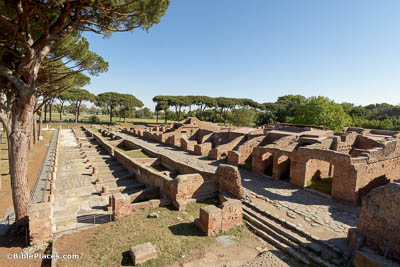Located at the mouth of the Tiber River, ancient Ostia was one of Rome’s harbor towns. Ancient tradition claims that King Ancus Marcius of Rome built this harbor in the 7th century BC. However, the earliest remains date only to the 4th century BC. The town served as an important commercial harbor, reaching its zenith in the 2nd century AD, when it organized Rome’s food supply. By the 3rd century AD, however, the city had begun to decline in importance. Ostia gradually lost trade and malaria eventually consumed the port.
Ostia

Brief History
Archaeology at Ostia
Many of the ruins at Ostia are well-preserved, and the site has enjoyed consistent excavation efforts for more than a century. As a result, roughly two-thirds of the ancient city’s original area has been uncovered. Nowhere is this long and meticulous work more evident than in the Small Market. Constructed around AD 120, this structure was a group of storehouses used to hold the edible goods that entered Ostia via its harbor. Today it serves as a place to store archaeological fragments, of which the portion shown here is only a very small percentage.


Bathhouse Mosaics
Hundreds of mosaics have been found at Ostia. They are especially ubiquitous in the city’s many bathhouses, where black-and-white figures such as these cover the floorspace. Mythological and athletic scenes are especially common, and the mosaics here (photographed in the Baths of the Porta Marina) provide an example of the latter.
Plaza of the Guilds
Ostia’s Plaza of the Guilds, or Piazzale delle Corporazioni, held 70 commercial “offices” with mosaic floors portraying the specific trades and guilds that once had a presence here. Some of those trades were ship repairers, customs officials, and dock maintenance workers. Because of how small each “office” is, the precise purpose of this plaza has been debated. Most likely, though, they served as meeting places to discuss business.


Mill-Bakery
In ancient Rome, milling and baking were typically done in the same place. Several such mill-bakeries have been found in Ostia, including this example from the early 2nd century AD. They were clearly built to maximize output, with several stations each for grinding and kneading. Pictured here is the mill-bakery’s main hall, where the grinding and kneading took place using animal-powered machines. A separate room housed a large oven for baking, and the finished loaves were likely sold in adjacent shops.
First-Century Synagogue
Located near the water’s edge, this ancient synagogue includes remains from the 1st century AD, but most of the building dates to the 4th century AD. Archaeologists discovered it in the early 1960s during construction of an airport. The Jewish symbols found in the structure are strong evidence that this was, indeed, a synagogue. If the identification of the structure’s earliest phase is accurate, that makes it one of the oldest known synagogues in the world.


Download all of our Rome photos!
$24.00 $29.99 FREE SHIPPING
Related Websites
Ostia (World History Encyclopedia) A good overview of the city’s history and major features.
Ostia-Antica.org (official page) A website that has almost everything someone could possibly want to know about Ostia, despite being somewhat tricky to navigate.
Ostia: What the Bricks and Stones Tell Us (Popular Archaeology) A number of nice photos accent this article.
Ancient Ostia (Rome in the Footsteps of an XVIIIth Century Traveller) This page is a little hard to look at, but it has lots of photos and helpful information.
‘Ostia Antica’: secrets behind once-great Roman Empire port (YouTube) This 4-minute video offers some information about Ostia (mostly in connection with Augustine and his mother), but it is most valuable for its nice views of the site.
Mosaics are Cool (personal page) This page highlights numerous photos of the remarkable mosaics at Ostia.
Ostia (Italy Review) This is a travel guide for those hoping to visit, including highlights of nearby things to do.